Contents
- 1. Users Manual Part 1
- 2. Users Manual Part 2
Users Manual Part 2
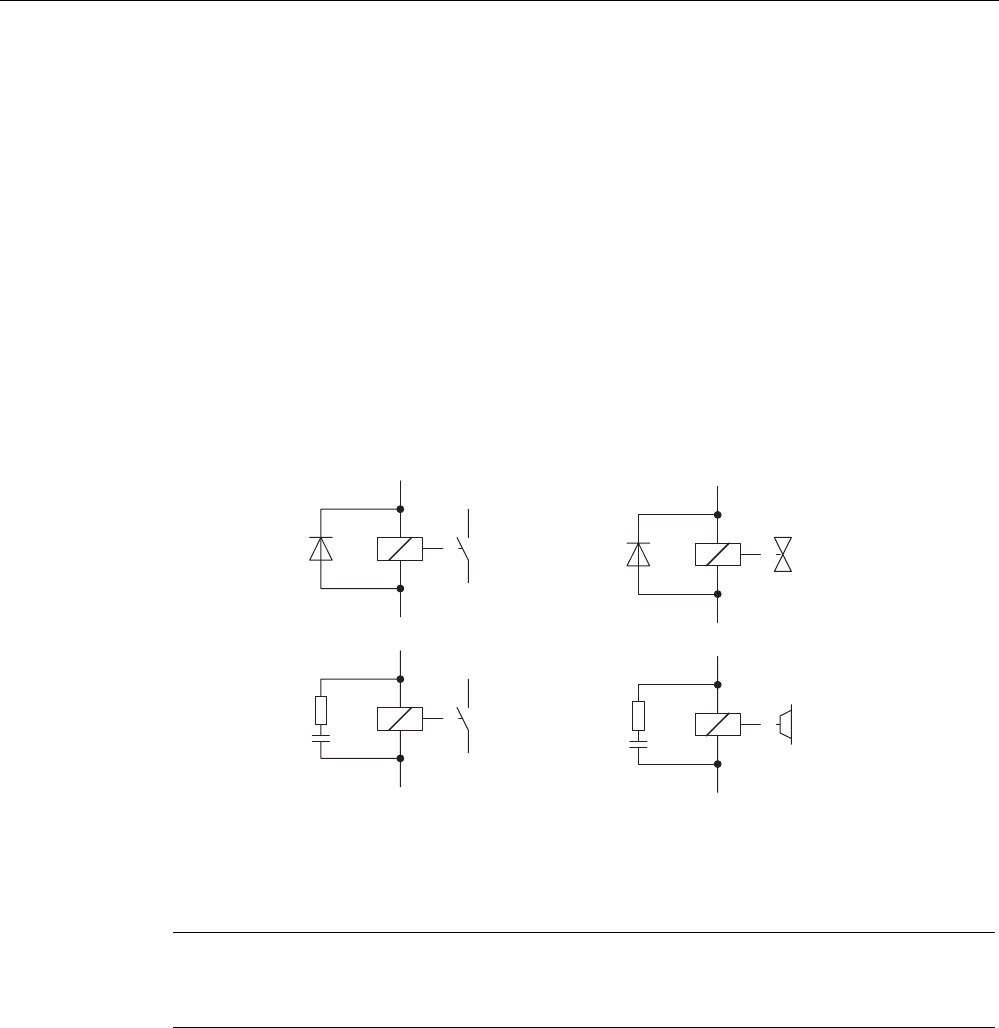
RF 300 system planning
4.6 EMC Guidelines
RF 300
System Manual, 05/2005, (4)J31069 D0166-U001-A1-7618, -- 4-35
4.6.6 Prevention of interference sources
A high level of immunity to interference can be achieved by avoiding interference sources.
All switched inductances are a frequent source of interference in plants.
Suppression of inductance
Relays, contactors, etc. generate interference voltages and must therefore be suppressed
using one of the circuits below.
Even with small relays, interference voltages of up to 800 V occur on 24 V coils, and
interference voltages of several kV occur on 230 V coils when the coil is switched. The use
of freewheeling diodes or RC circuits prevents interference voltages and thus stray
interference on conductors installed parallel to the coil conductor.
9DOYHV
%UDNHV
5HOD\FRLOV
&RQWDFWRUV
Figure 4-13 Suppression of inductance
Note
All coils in the cabinet should be suppressed. The valves and motor brakes are frequently
forgotten. Fluorescent lamps in the control cabinet should be tested in particular.
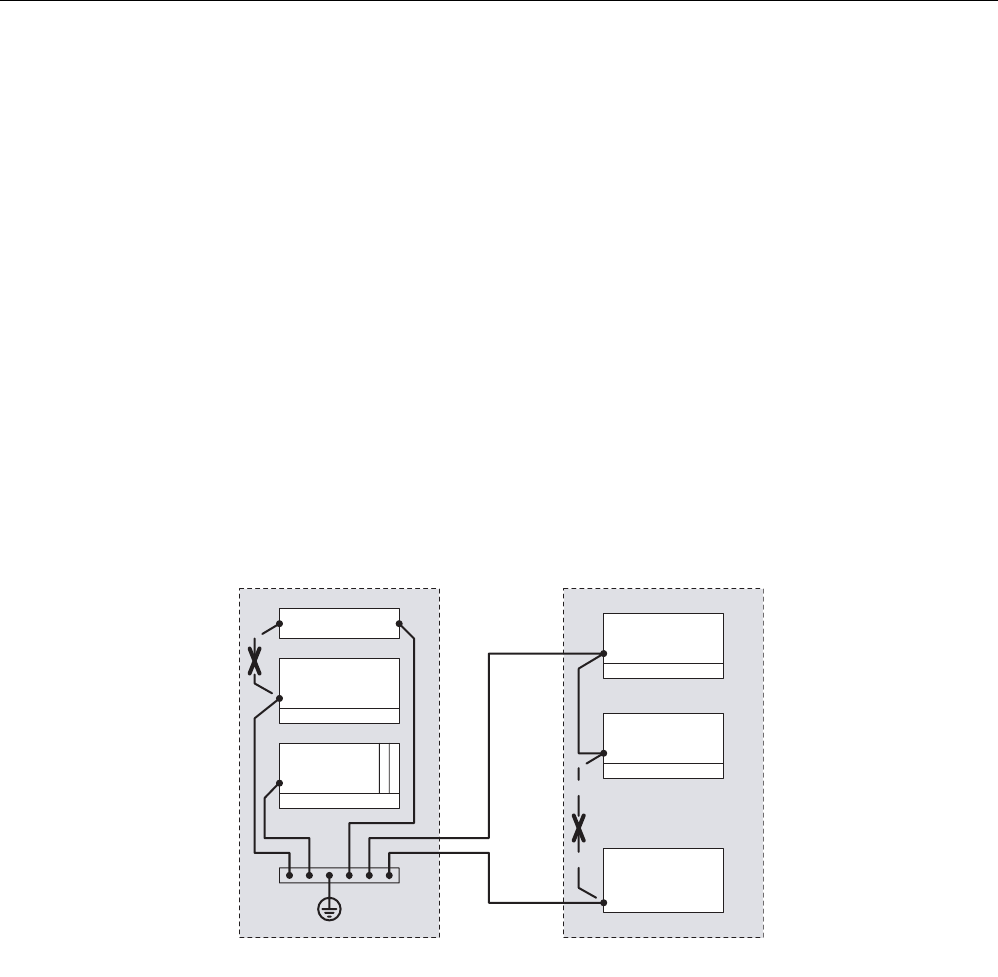
RF 300 system planning
4.6 EMC Guidelines
RF 300
4-36 System Manual, 05/2005, (4)J31069 D0166-U001-A1-7618, --
4.6.7 Equipotential bonding
Potential differences between different parts of a plant can arise due to the different design
of the plant components and different voltage levels. If the plant components are connected
across signal cables, transient currents flow across the signal cables. These transient
currents can corrupt the signals.
Proper equipotential bonding is thus essential.
• The equipotential bonding conductor must have a sufficiently large cross section (at least
10 mm2).
• The distance between the signal cable and the associated equipotential bonding
conductor must be as small as possible (antenna effect).
• A fine-strand conductor must be used (better high-frequency conductivity).
• When connecting the equipotential bonding conductors to the centralized equipotential
bonding strip, the power components and non-power components must be combined.
3RZHUVXSSO\
3/&
(8
(8
(8
'ULYH
,QFRUUHFW
,QFRUUHFW
&DELQHW &DELQHW
Figure 4-14 Equipotential bonding
The better the equipotential bonding in a plant, the smaller the chance of interference due to
fluctuations in potential.
Equipotential bonding should not be confused with protective earthing of a plant. Protective
earthing prevents the occurrence of excessive contact voltages in the event of device faults.
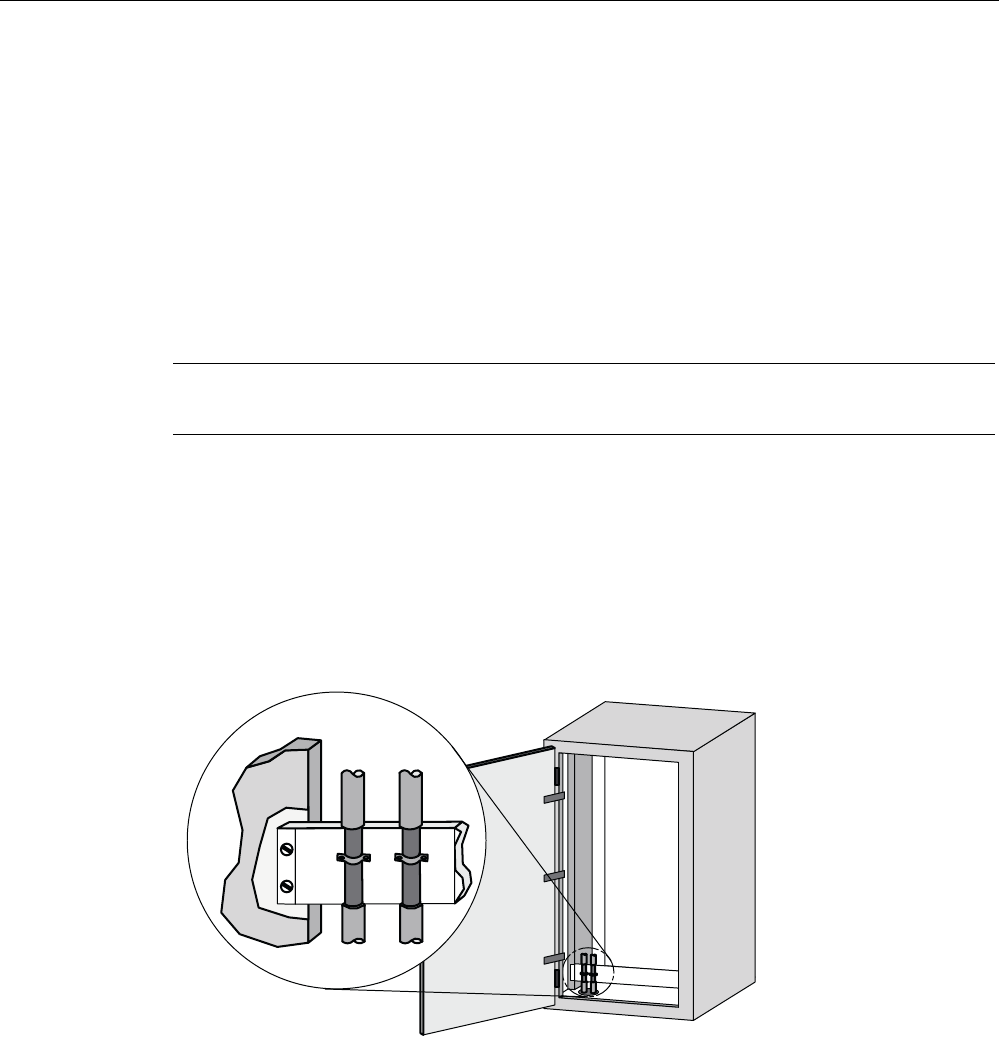
RF 300 system planning
4.6 EMC Guidelines
RF 300
System Manual, 05/2005, (4)J31069 D0166-U001-A1-7618, -- 4-37
4.6.8 Cable shielding
Signal cables must be shielded in order to prevent coupling of interference.
The best shielding is achieved by installing the cables in steel tubes. However, this is only
necessary if the signal cable is routed through an environment prone to particular
interference. It is usually adequate to use cables with braided shields. In either case,
however, correct connection is vital for effective shielding.
Note
An unconnected or incorrectly connected shield has no shielding effect.
As a rule:
• For analog signal cables, the shield should be connected at one end on the receiver side
• For digital signals, the shield should be connected to the enclosure at both ends
• Since interference signals are frequently within the HF range (> 10 kHz), a large-area HF-
proof shield contact is necessary
Figure 4-15 Cable shielding
The shielding bus should be connected to the control cabinet enclosure in a manner allowing
good conductance (large-area contact) and must be situated as close as possible to the
cable inlet. The cable insulation must be removed and the cable clamped to the shielding
bus (high-frequency clamp) or secured using cable ties. Care should be taken to ensure that
the connection allows good conductance.
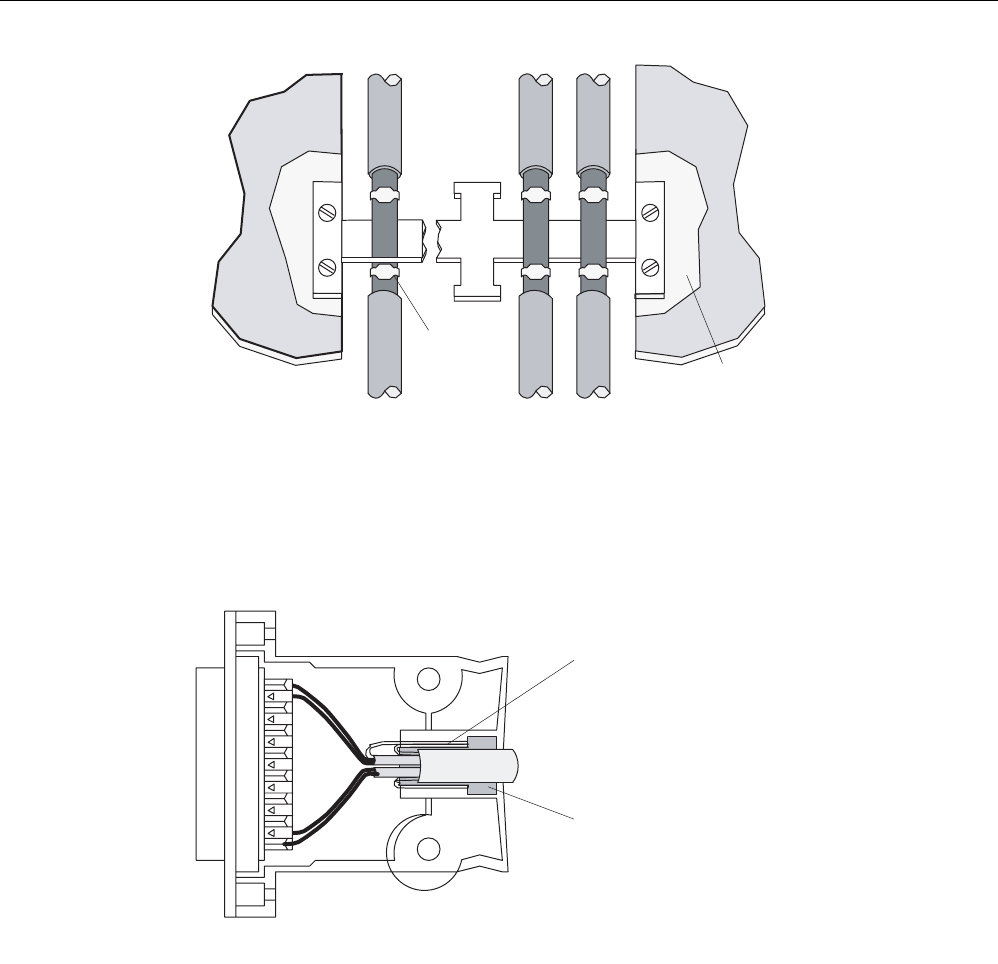
RF 300 system planning
4.6 EMC Guidelines
RF 300
4-38 System Manual, 05/2005, (4)J31069 D0166-U001-A1-7618, --
Cable tie
5HPRYHSDLQW
Figure 4-16 Connection of shielding bus
The shielding bus must be connected to the PE busbar.
If shielded cables have to be interrupted, the shield must be continued via the corresponding
connector housing. Only suitable connectors may be used for this purpose.
6KLHOGWXUQHGXSVLGHGRZQ
WKURXJKrDQG
FRQQHFWHGWRFRQQHFWRU
KRXVLQJ
5XEEHUVOHHYH
Figure 4-17 Interruption of shielded cables
If intermediate connectors, which do not have a suitable shield connection, are used, the
shield must be continued by fixing cable clamps at the point of interruption. This ensures a
large-area, HF-conducting contact.
RF 300
System Manual, 05/2005, (4)J31069 D0166-U001-A1-7618, -- 5-1
Readers 5
The reader ensures inductive communication with the transponders, and handles the serial
connection to the communication modules/interface modules and 8xIQ-Sense module.
Communication between the transponder and reader takes place over inductive alternating
fields.
The transmittable data volume between reader and transponder depends on:
• the speed at which the transponder moves through the transmission window of the
reader.
• the length of the transmission window.
• the transponder type (FRAM, EEPROM).
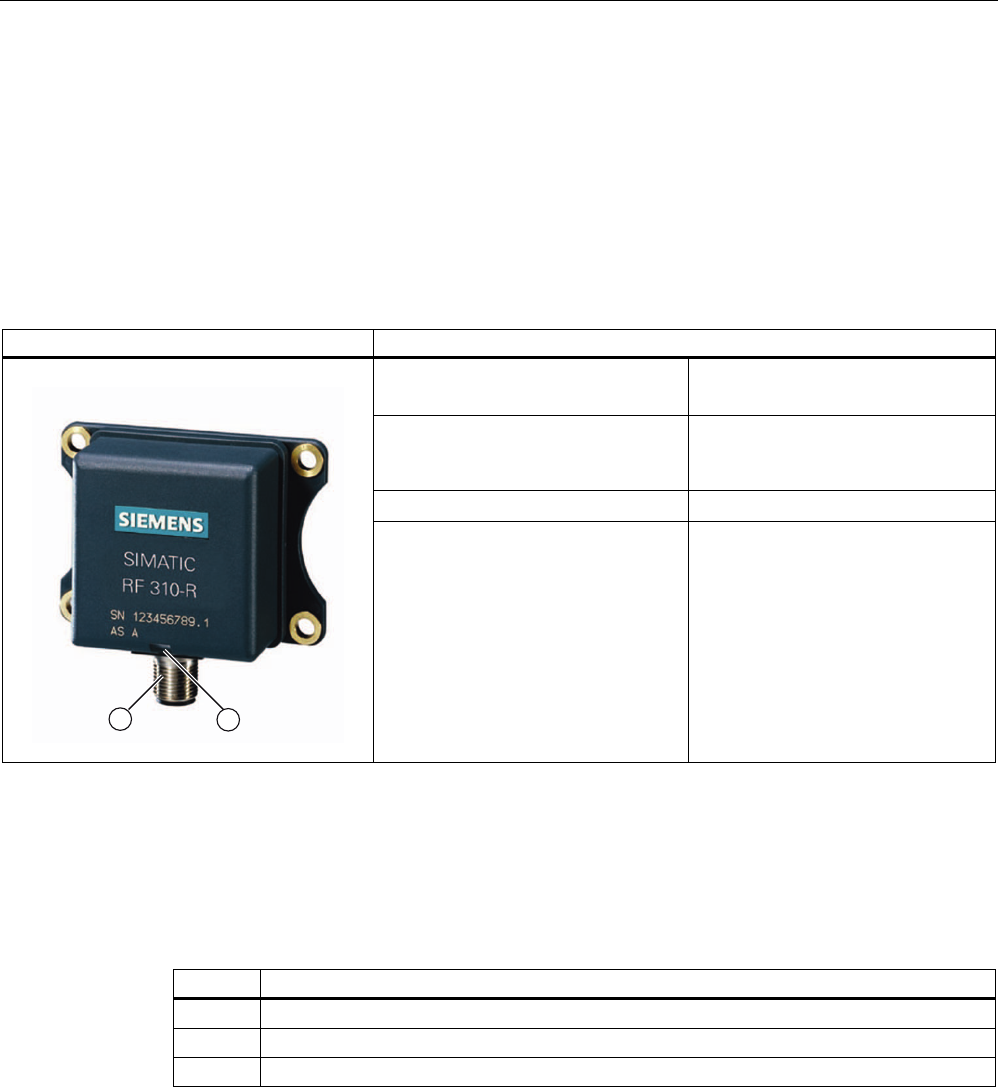
Readers
5.1 RF 310-R
RF 300
5-2 System Manual, 05/2005, (4)J31069 D0166-U001-A1-7618, --
5.1 5.1 RF 310-R
5.1.1 Features
Reader RF 310-R Features
Design (1) IQ-Sense interface
(2) Operating indicator
Applications Identification tasks on small
assembly lines in harsh industrial
environments
Read/write distance to transponder 30 mm max.
Data transmission rate Read: 50 bytes/s
Write: approx. 40 bytes/s
5.1.2 Indicators
Table 5-1 RF 310-R indicators
Color Meaning
Green Operating voltage available
Yellow Transponder present
Red Fault
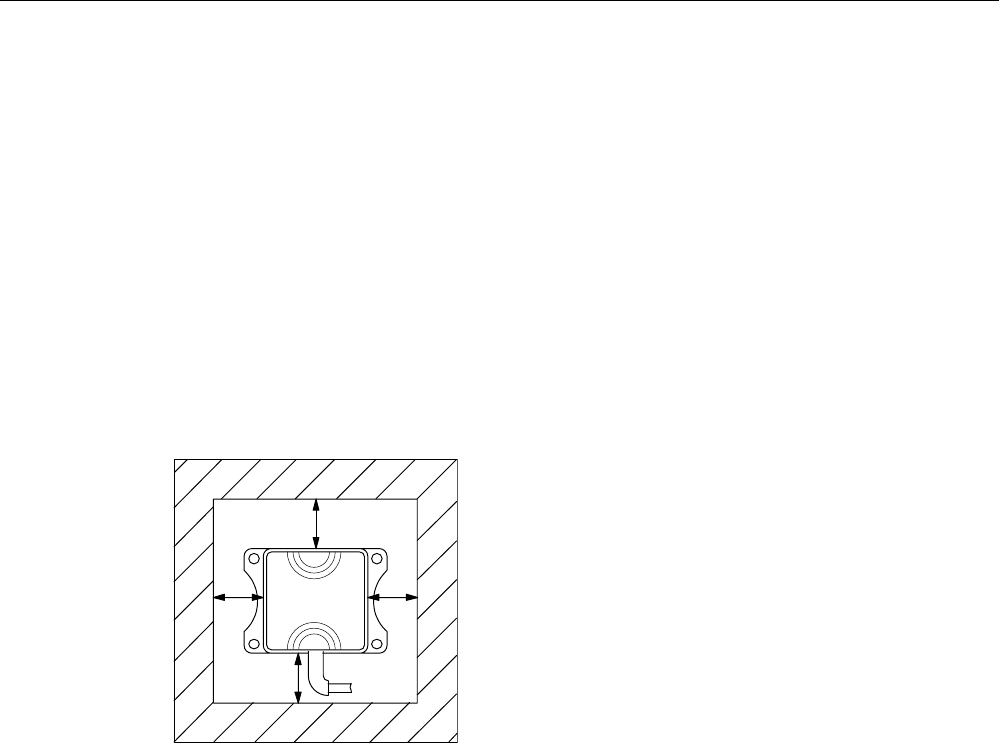
Readers
5.1 RF 310-R
RF 300
System Manual, 05/2005, (4)J31069 D0166-U001-A1-7618, -- 5-3
5.1.3 Transmission window
Ensuring reliable data exchange
The "center point" of the transponder must be situated within the transmission window.
5.1.4 Metal-free area
The RF 310-R can be flush-mounted in metal. Please allow for a possible reduction in the
field data values.
D
D
DD
6,0$7,&
5)5
Figure 5-1 Metal-free area for RF 310-R
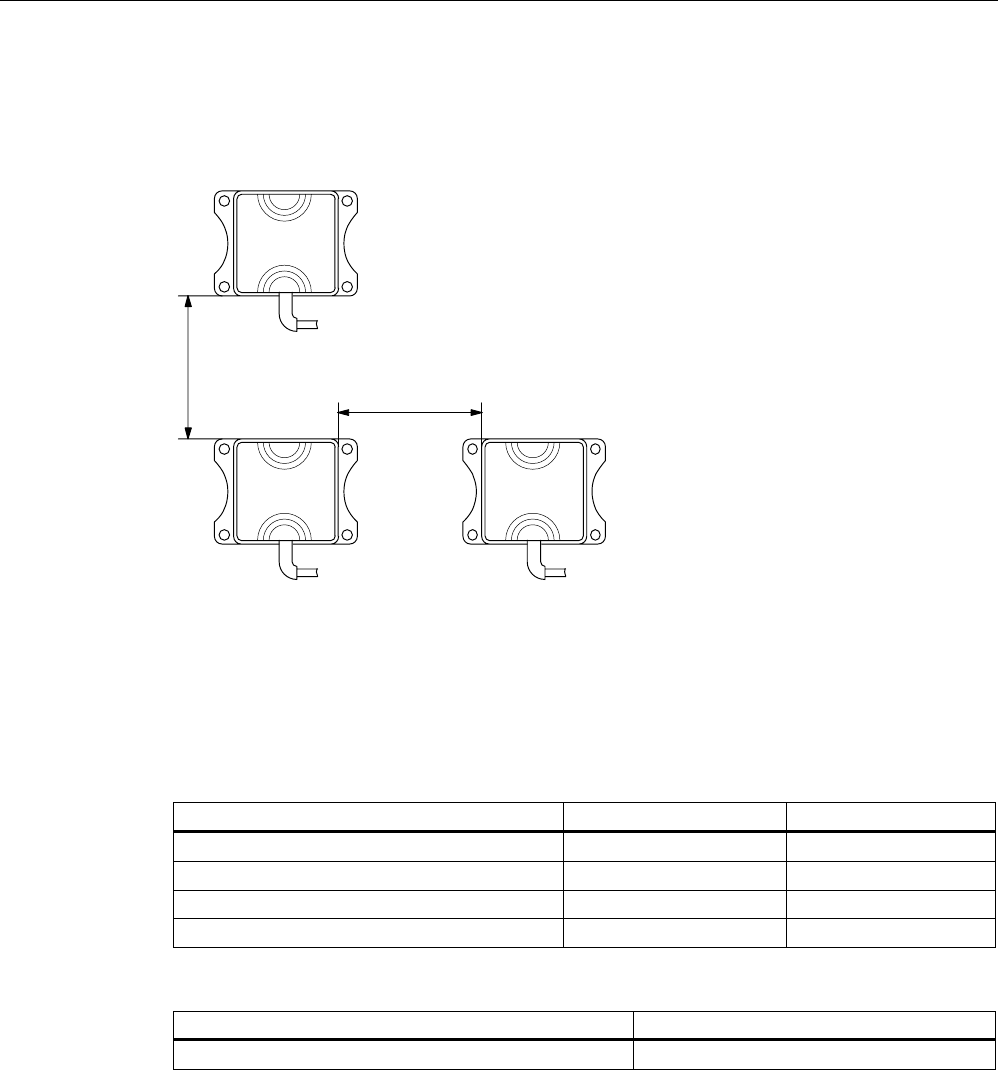
Readers
5.1 RF 310-R
RF 300
5-4 System Manual, 05/2005, (4)J31069 D0166-U001-A1-7618, --
5.1.5 Minimum distance between several RF 310-R units
ุPP
0LQLPXPGLVWDQFHIURP5)5WR5)5
'
'
'
5)5
5)5 5)5
Figure 5-2 Minimum distance between several RF 310-R units
5.1.6 RF 310-R field data
RF 320-T transponder RF 340-T transponder
Working distance (Sa) 0-12 mm 0-20 mm
Limit distance (Sg) 18 mm 30 mm
Length of the transmission window (L) 30 mm 40 mm
Width of the transmission window (W) 12 mm 16 mm
Reader RF 310-R to reader RF 310-R
Minimum distance 400 mm
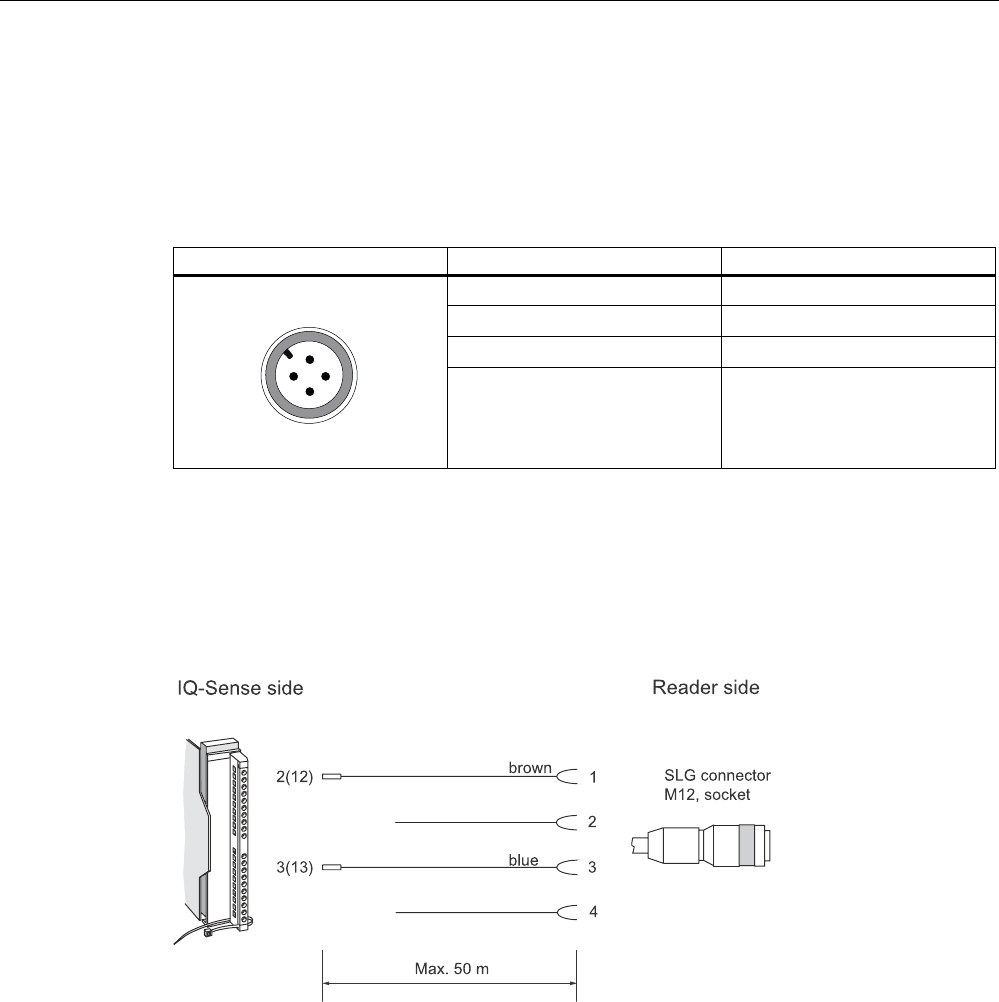
Readers
5.1 RF 310-R
RF 300
System Manual, 05/2005, (4)J31069 D0166-U001-A1-7618, -- 5-5
5.1.7 Pin assignment of the IQ-Sense interface
Table 5-2 RF 310-R pin assignment
Pin Pin, device end, 4-pin M12 Assignment
1 IQ-Sense
2 Not assigned
3 IQ-Sense
4 Not assigned
5.1.8 Cable and connector pin assignment
The following figure shows the cable and connector pin assignment of the connecting cable
between 8xIQ-Sense and RF 310-R.
Figure 5-3 Cable and connector pin assignment

Readers
5.1 RF 310-R
RF 300
5-6 System Manual, 05/2005, (4)J31069 D0166-U001-A1-7618, --
5.1.9 Technical data of the RF 310-R
Table 5-3 Technical data of the RF 310-R
Inductive interface to the transponder
Transmission frequency for power/data
13.56 MHz
Interface to SIMATIC S7-300
Required master module
RFID channels (RF 310-R)
Hybrid operation with other profiles
IQ-Sense, 2-wire polarity independent
8-IQ-Sense (6ES7 338-7XF00-0AB0)
Max. 2 possible per master module
Max. 4 Opto-BERO, 1x SIMATIC RF 310-R
Cable length, reader Max. 50 m (unshielded cable)
Read/write distances of reader See field data RF 310-R
Minimum distance between 2 RF 310-R units ≥ 400 mm
SLG data transmission rate
• Read
• Write
Approx. 50 bytes/s
Approx. 40 bytes/s
Traversal rate
• Read
• Write
Approx. 0.8 m/s (2 bytes)
Approx. 0.2 m/s (2 bytes)
Function Read, write, initialize transponder
Multi-tag no
Power supply via IQ-Sense master module 24 V DC
Indicators 2-color LED (operating voltage, presence, error)
Plug connector M12 (4-pin)
Housing
• Dimensions (in mm)
• Color
• Material
55 x 75 x 30 (not including M12 connector)
anthracite
plastic PA 12
Fixing 4 x M5 screws
Ambient temperature
• During operation
• Storage and transport
• -25°C to +70°C
• -40°C to +85°C
Degree of protection per EN 60529
Shock to EN 60 721-3-7 Class 7 M2
Overall shock response spectrum type II
Vibration to EN 60 721-3-7 Class 7M2
IP65
50 g
1 g (9 to 200 Hz)
1.5 g (200 to 500 Hz)
Weight Approx. 200 g
Approvals • Radio to R&TTE guidelines EN 300 330,
EN 301 489
• CE
• UL
• FCC

Readers
5.1 RF 310-R
RF 300
System Manual, 05/2005, (4)J31069 D0166-U001-A1-7618, -- 5-7
5.1.10 FCC information
Siemens SIMATIC RF 300
FCC ID: xxxxxxxx
This device complies with part 15 of the fcc rules. Operation is subject to the following two
conditions:
(1) This device may not cause harmful interference, and
(2) This device must accept any interference received, including interference that may cause
undesired operation.
Caution
Any changes or modifications not expressly approved by the party responsible for
compliance could void the user's authority to operate the equipment.
5.1.11 RF 310-R ordering data
RF 310-R Order No.
with IQ-Sense interface for SIMATIC S7-300
ET 200M
IP65
-25° to +70°C
55 x 75 x 30 mm
Max. limit distance: 30 mm
with integrated antenna
6GT2 801-0AA00
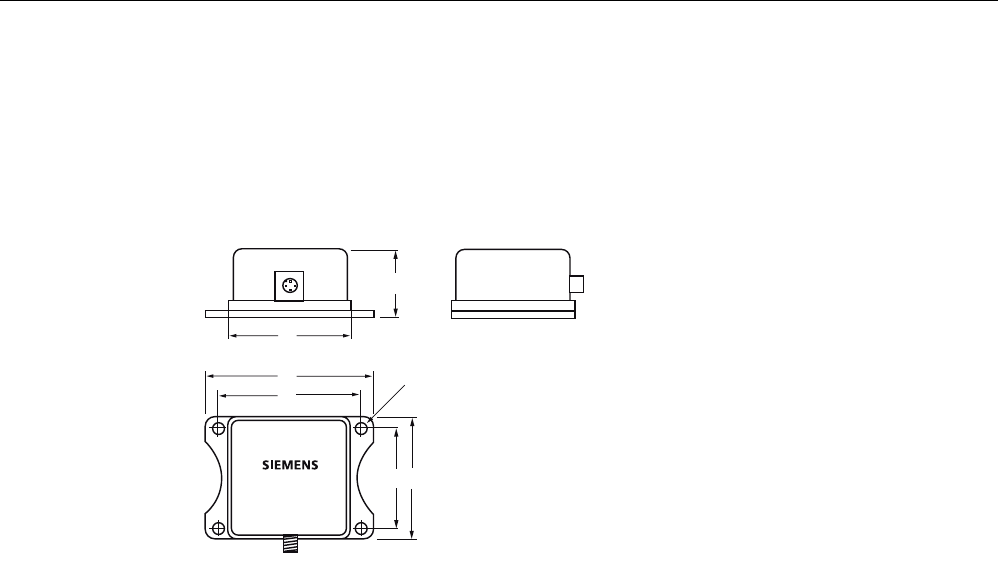
Readers
5.1 RF 310-R
RF 300
5-8 System Manual, 05/2005, (4)J31069 D0166-U001-A1-7618, --
5.1.12 Dimension drawing
6,0$7,&
5)5
Figure 5-4 RF 310-R dimension drawing
RF 300
System Manual, 05/2005, (4)J31069 D0166-U001-A1-7618, -- 6-1
Transponder/tags 6
Transponders consist predominantly of logic, FRAM and/or EEPROM.
If a transponder moves into the transmission field of the reader, the necessary power for all
of the circuit components is generated and monitored by the power supply unit. The pulse-
coded information is prepared in such a way that it can be processed further as pure digital
signals. The handling of data, including check routines, is performed by the control unit,
which also manages the various memories.
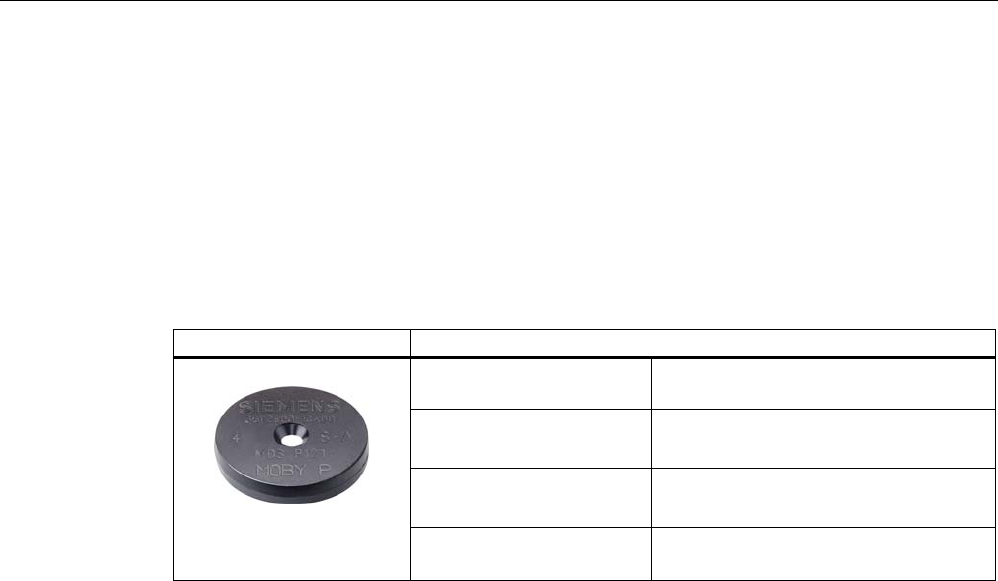
Transponder/tags
6.1 RF 320-T
RF 300
6-2 System Manual, 05/2005, (4)J31069 D0166-U001-A1-7618, --
6.1 6.1 RF 320-T
6.1.1 Features
RF 320-T transponder Features
Applications Identification tasks on small assembly
lines in harsh industrial environments
Memory Read-only area (4 bytes UID)
User data area (20 bytes)
Read/write range Max. 18 mm
(in conjunction with reader RF 310-R)
Mounting on metal No: distance to metal must be at least 10
mm
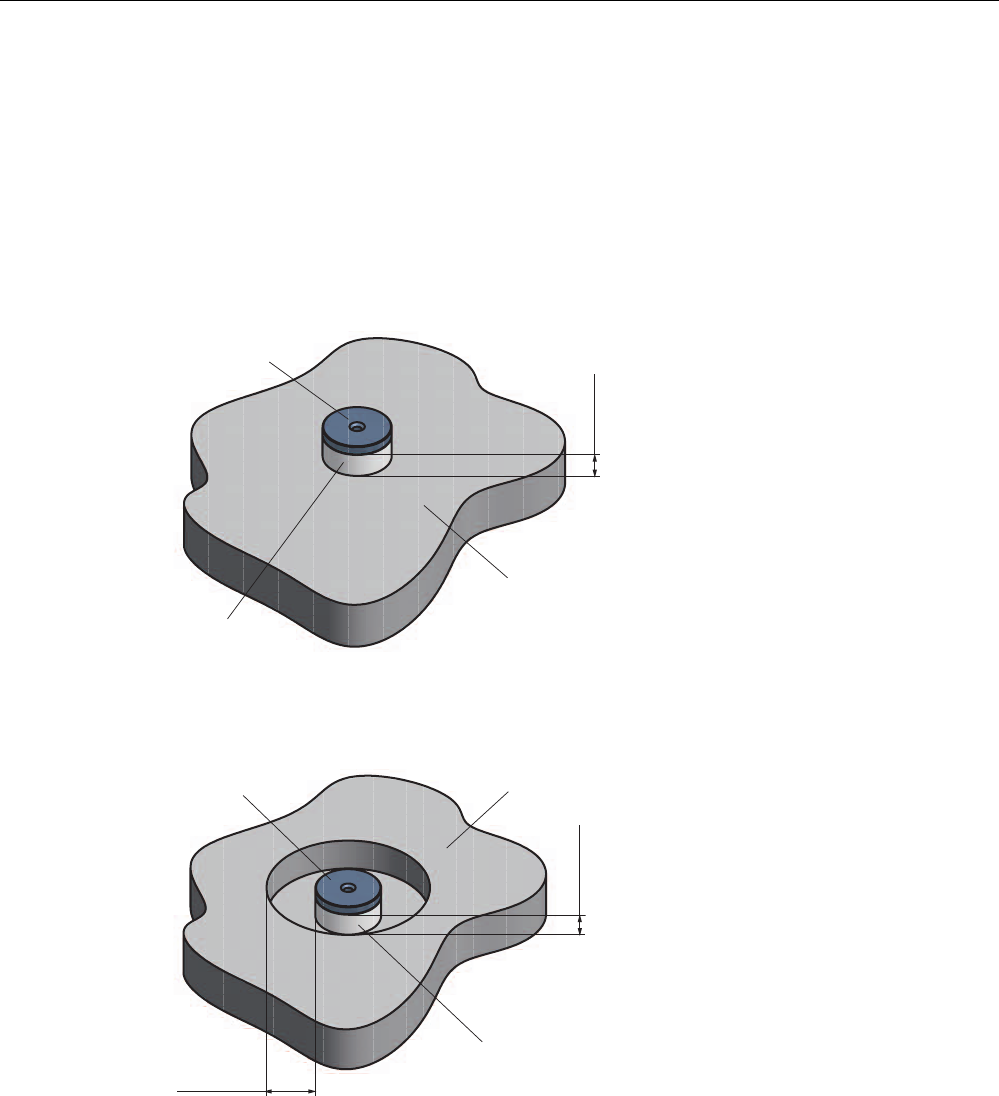
Transponder/tags
6.1 RF 320-T
RF 300
System Manual, 05/2005, (4)J31069 D0166-U001-A1-7618, -- 6-3
6.1.2 Metal-free area
Direct mounting of the RF 320-T on metal
Direct mounting of the RF 320-T on metal is not allowed.
The following figures show the minimum distance between the RF 320-T and metal:
1RQPHWDO
0HWDO
K!PP
'DWDPHPRU\
Figure 6-1 Mounting of the RF 320-T on metal with spacer
Flush-mounting of the RF 320-T in metal
D!PP
K!PP
'DWDPHPRU\ 0HWDO
1RQPHWDO
Figure 6-2 Flush-mounting of the RF 320-T in metal with spacer
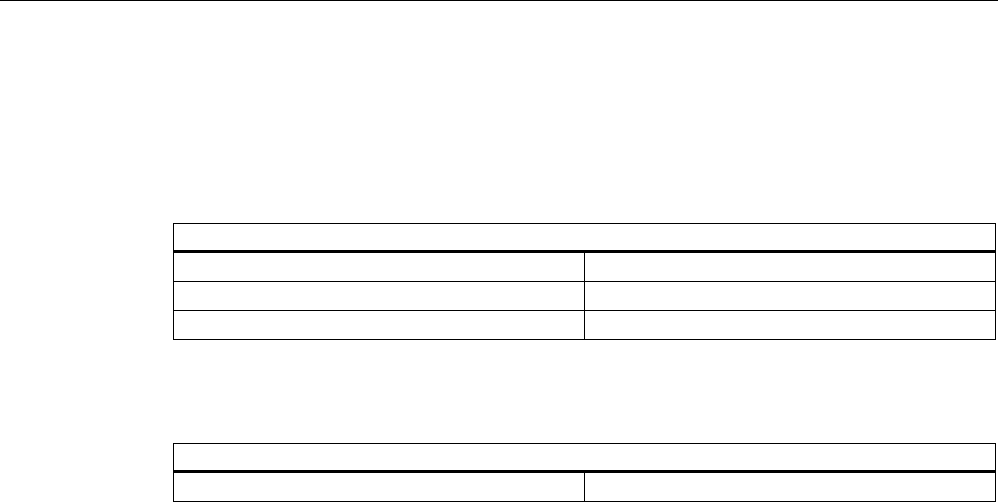
Transponder/tags
6.1 RF 320-T
RF 300
6-4 System Manual, 05/2005, (4)J31069 D0166-U001-A1-7618, --
6.1.3 Field data
Table 6-1 Field data for transponder RF 320-T to reader RF 310-R
Transponder RF 320-T to reader RF 310-R
Working distance (Sa) 0 to 12 mm
Limit distance (Sg) 18 mm
Transmission window (L) 30 mm
Table 6-2 Field data for transponder RF 320-T to RF 320-T
Transponder RF 320-T to transponder RF 320-T
Minimum distance 100 mm

Transponder/tags
6.1 RF 320-T
RF 300
System Manual, 05/2005, (4)J31069 D0166-U001-A1-7618, -- 6-5
6.1.4 Technical data
Table 6-3 Technical data of the RF 320-T
Memory size 20 bytes EEPROM (r/w), 4 bytes UID (ro)
Memory organization Byte-oriented access, write protection possible in
4-byte blocks
MTBF 8 x 106 h
Read cycles Unlimited
Write cycles, min. 50 000
at ≤ 40 °C, typical > 100 000
Data retention time > 10 years (at < +40 °C)
Read/write distance, max. 18 mm (see field data)
Energy source Inductive power transmission
Shock/vibration-resistant to EN 60721-3-7, Class
7 M3
100 g/20 g
Torsion and bending load not permissible
Fixing Adhesive/M3 screws
Recommended spacing from metal > 10 mm
Degree of protection per EN 60529 • IP67/IPX9K
Housing
• Dimensions
• Color/material
Button
• Ø 27 mm x 4 mm
• Black/epoxy resin
Ambient temperature
• During operation
• Storage and transport
• -25 to +85 °C
• -40 to +125 °C
Weight Approx. 5 g
Note
All the technical data listed are typical data and are applicable for an ambient temperature of
between 0 C and +50°C and a metal-free environment.
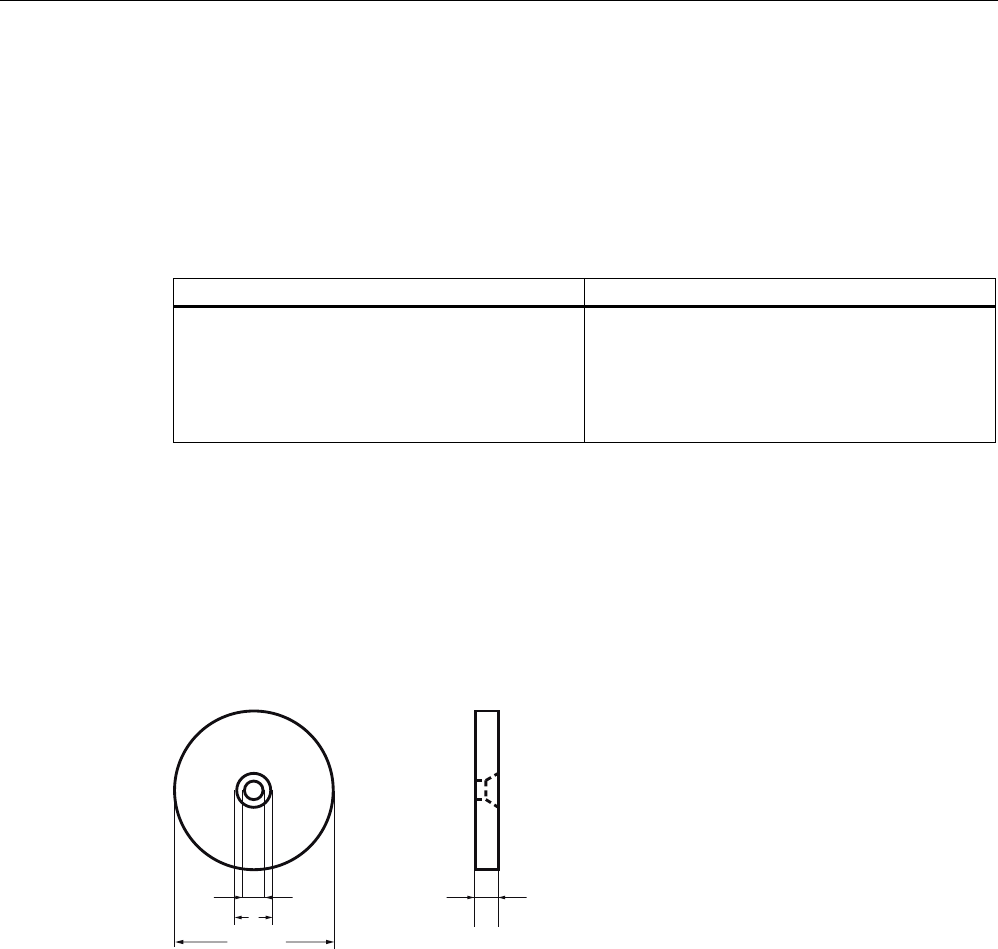
Transponder/tags
6.1 RF 320-T
RF 300
6-6 System Manual, 05/2005, (4)J31069 D0166-U001-A1-7618, --
6.1.5 Ordering data
RF 320-T transponder Order No.
Transponder RF 320-T, button,
20-byte EEPROM
IP 67
-25 to +85 °C
d = 27 mm x 4 mm
6GT2 800-1CA00
6.1.6 Dimension drawing
Dimensions of the device
s
s
Dimensions in millimeters
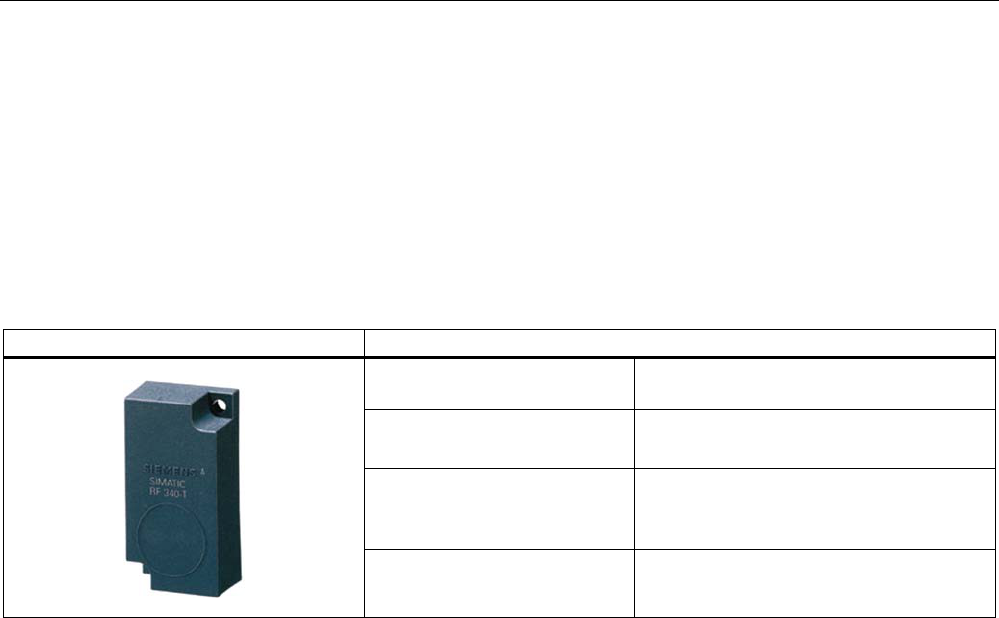
Transponder/tags
6.2 RF 340-T
RF 300
System Manual, 05/2005, (4)J31069 D0166-U001-A1-7618, -- 6-7
6.2 6.2 RF 340-T
6.2.1 Features
RF 340-T transponder Features
Applications Identification tasks on small assembly lines
in harsh industrial environments
Memory Read-only area (4 bytes UID)
Read/write memory (8 KB)
Read/write range
(in conjunction with reader RF
310-R)
Max. 30 mm
Mounting on metal Yes: can be directly mounted on metal

Transponder/tags
6.2 RF 340-T
RF 300
6-8 System Manual, 05/2005, (4)J31069 D0166-U001-A1-7618, --
6.2.2 Metal-free area
Direct mounting of the RF 340-T on metal is allowed.
Direct mounting of the RF 340-T on metal
0HWDO
Figure 6-3 Direct mounting of the RF 340-T on metal:
Flush-mounting of the RF 340-T in metal:
D
E
0HWDO
Figure 6-4 Flush-mounting of the RF 340-T in metal:
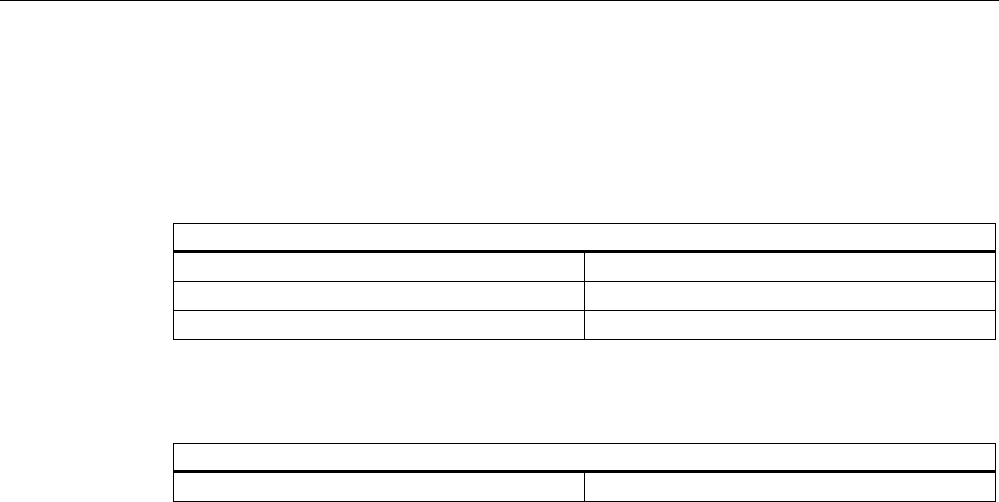
Transponder/tags
6.2 RF 340-T
RF 300
System Manual, 05/2005, (4)J31069 D0166-U001-A1-7618, -- 6-9
6.2.3 Field data
Table 6-4 Field data for transponder RF 340-T to reader RF 310-R
Transponder RF 340-T to reader RF 310-R
Working distance (Sa) 0 to 20 mm
Limit distance (Sg) 30 mm
Transmission window (L) 40 mm
Table 6-5 Transponder RF 340-T to transponder RF 340-T
Transponder RF 340-T to transponder RF 340-T
Minimum distance 100 mm
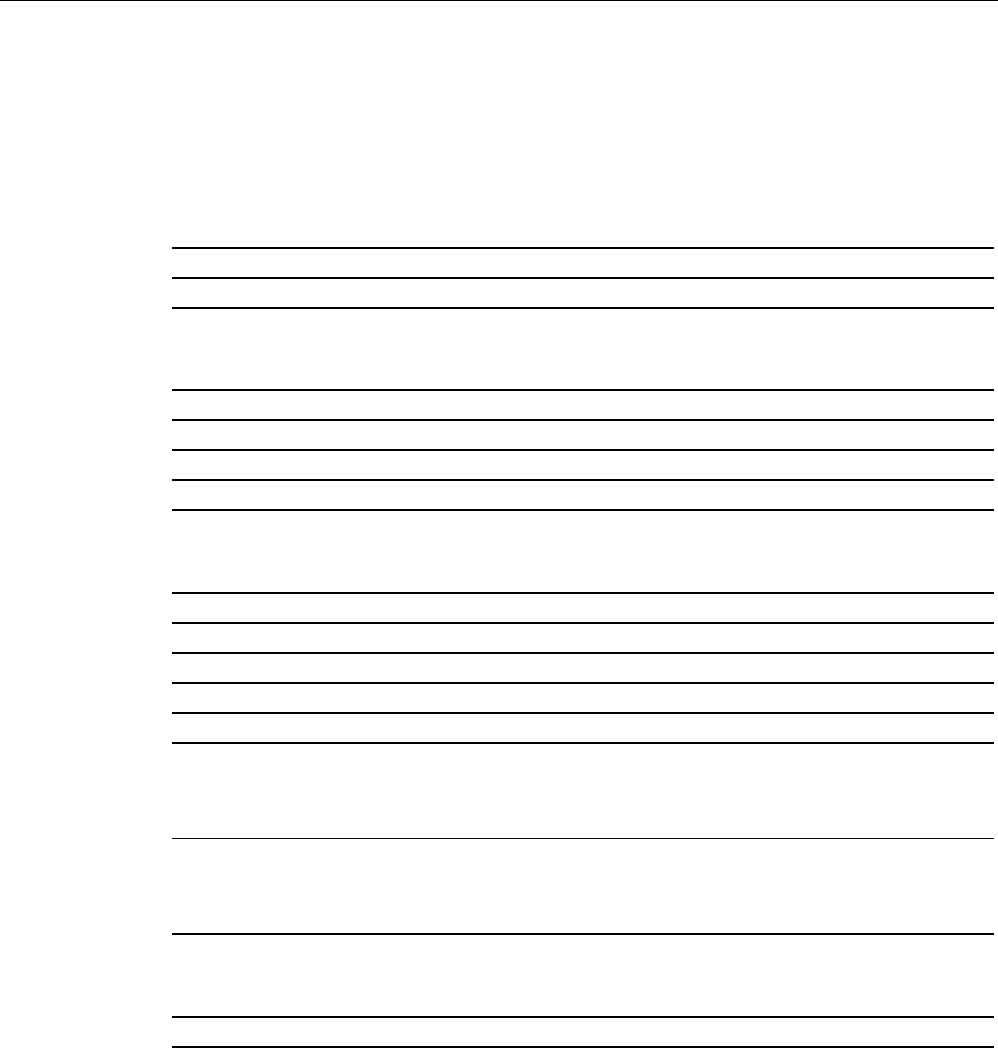
Transponder/tags
6.2 RF 340-T
RF 300
6-10 System Manual, 05/2005, (4)J31069 D0166-U001-A1-7618, --
6.2.4 Technical data
Table 6-6 Technical data of the RF 340-T
Memory size 8 KB
Memory organization 8 bit / bytewise
Memory configuration
• Serial number (UID)
• Application memory
4 bytes (fixed code)
8188 bytes r/w
Storage technology FRAM
MTBF, at +40 °C > 1.5 x 106 h
Write cycles, at +40°C Virtually unlimited (>1010)
Read cycles Unlimited
Transmission rate
• Reading
• Writing
with RS 422 reader:
Approx. 0.3 ms / byte
approx. 0.3 ms / byte
with IQ-Sense reader:
Approx. 20 ms / byte
approx. 25 ms / byte
Data retention > 10 years
Read/write distance 0 to max. 60 mm (depends on reader used)
Multitag capability max. 4 transponders
Recommended spacing from metal can be directly mounted on metal
Power supply Inductive, without battery
Degree of protection to EN 60529
Shock to EN 60721-3-7
Vibration to EN 60721-3-7
Torsion and bending load
IP68/IPX9K
50 g
20 g
Not permitted permanently
Housing dimensions
Color
Material
Fixing
48 x 25 x 15 mm (L x W x H)
Anthracite
PA12
2 screws (M3)
Ambient temperature
• During operation
• Storage and transport
-25°C to +85°C
-40°C to +85°C
Weight Approx. 25 g
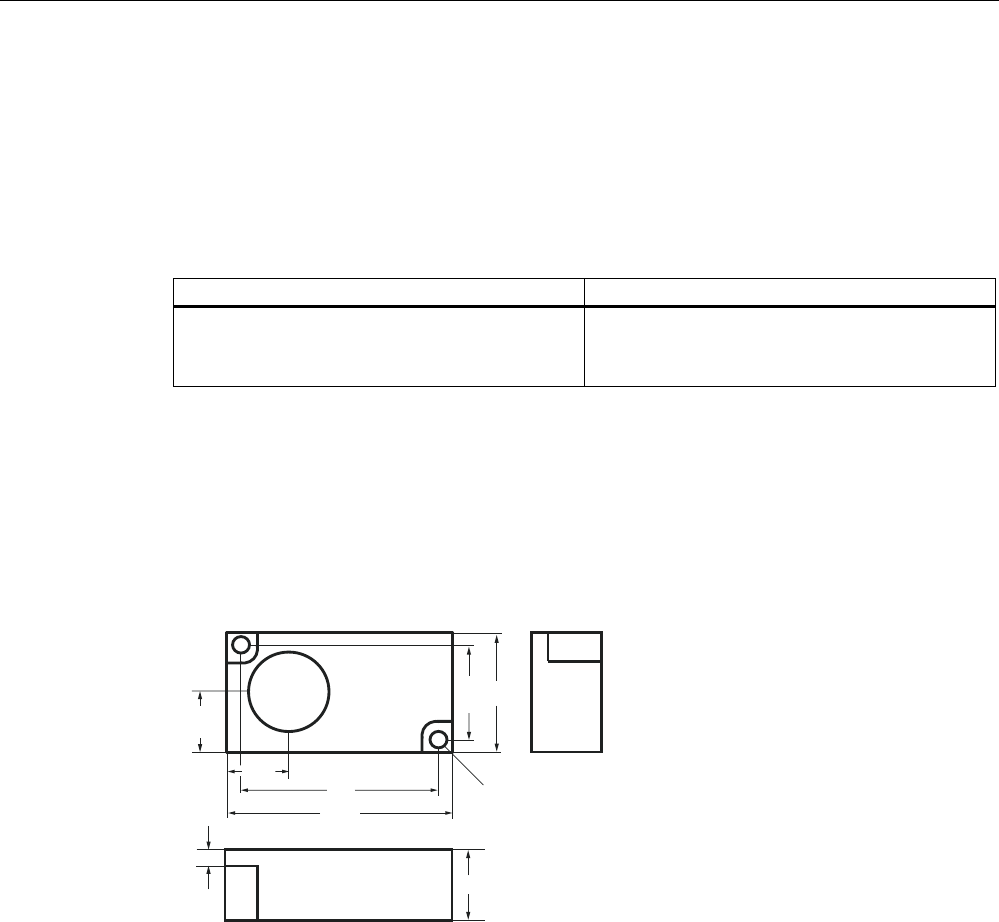
Transponder/tags
6.2 RF 340-T
RF 300
System Manual, 05/2005, (4)J31069 D0166-U001-A1-7618, -- 6-11
6.2.5 Ordering data
Ordering data
RF 340-T Order No.
RF 340-T transponder
8 KB FRAM
48 x 25 x 15 mm (L x W x H)
6GT2 800-4BB00
6.2.6 Dimension drawing
Dimensions of the device
6,(0(16
6,0$7,&
5)7
Dimensions in millimeters

Transponder/tags
6.2 RF 340-T
RF 300
6-12 System Manual, 05/2005, (4)J31069 D0166-U001-A1-7618, --
RF 300
System Manual, 05/2005, (4)J31069 D0166-U001-A1-7618, -- 7-1
Communication modules 7
The communication modules (interface modules) are links between the RFID components
(reader and transponder) and the higher-level control systems (e.g. SIMATIC S7) or PC or
computers.
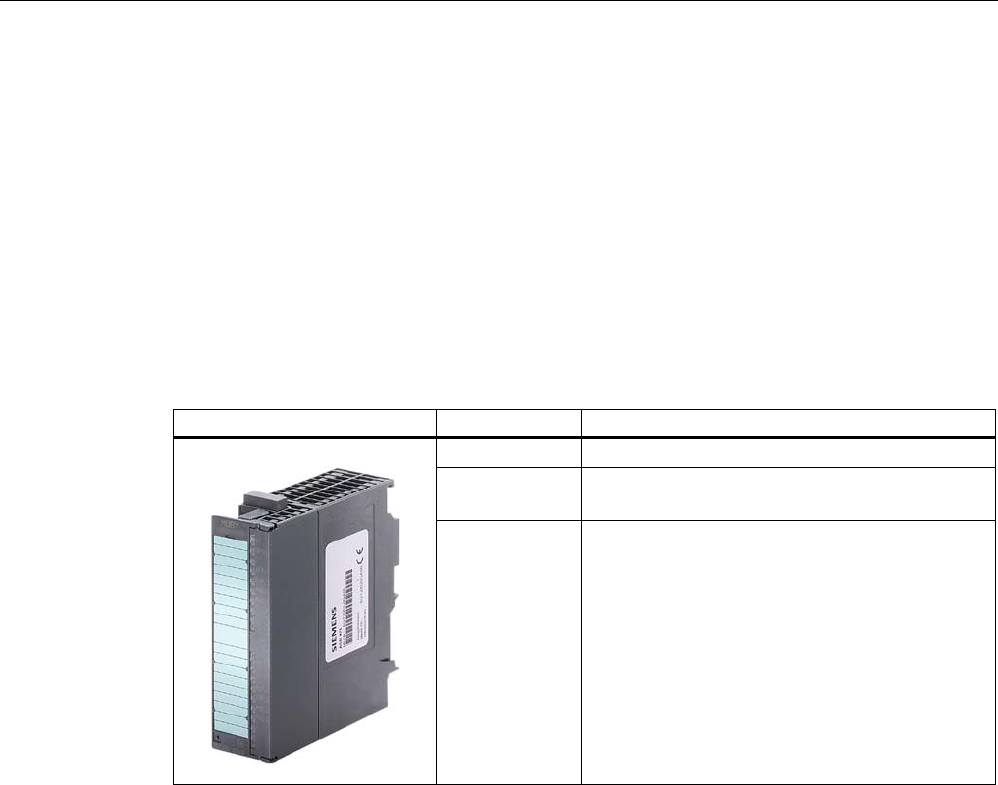
Communication modules
7.1 8xIQ-Sense
RF 300
7-2 System Manual, 05/2005, (4)J31069 D0166-U001-A1-7618, --
7.1 7.1 8xIQ-Sense
The 8xIQ-Sense module in conjunction with the RF 310-R handles the function of the
communication module in SIMATIC RF 300. It can be operated centrally in an S7-300 or
decentrally in an ET 200M.
7.1.1 Features
8xIQ-Sense Features
Operation Centralized or distributed
Communication with up to 8 IQ-Sense devices fitted with IQ-
Sense communication interfaces
Status displays Status LED for each channel (green) (for BERO
only)
Fault LED (red)
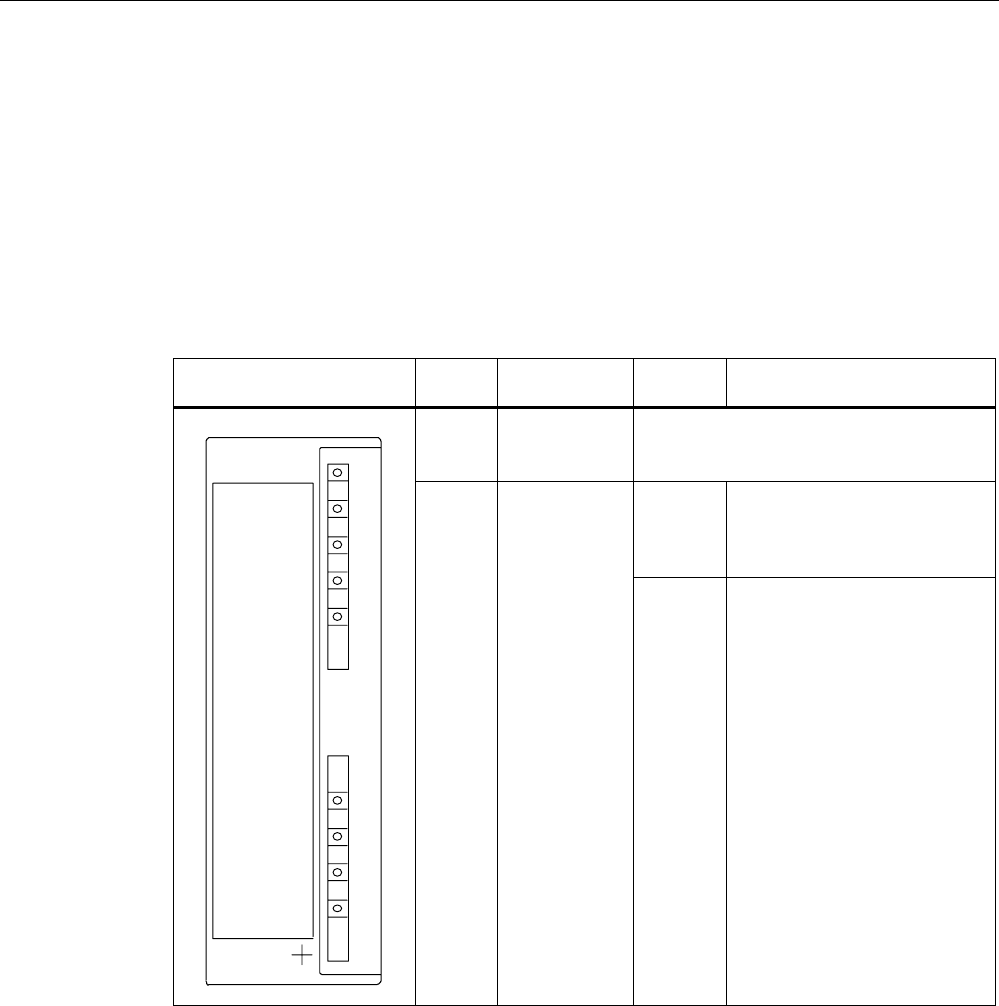
Communication modules
7.1 8xIQ-Sense
RF 300
System Manual, 05/2005, (4)J31069 D0166-U001-A1-7618, -- 7-3
7.1.2 Indicators
Status displays
The 8xIQ-Sense module has the following LEDs:
A green LED, which has no function for RFID devices, and a red SF LED (system fault LED),
which indicates the diagnostic state of the module.
LEDs Labeling LED
status
Meaning
Green
LED per
channel
0…7 Has no function here
Illuminate
d
Module fault, sensor fault,
active teach-in operation,
external auxiliary voltage
missing
6)
60
[,46HQVH
;)$%
;
Red SF
Not
illuminate
d
No fault or no active teach-in
operation
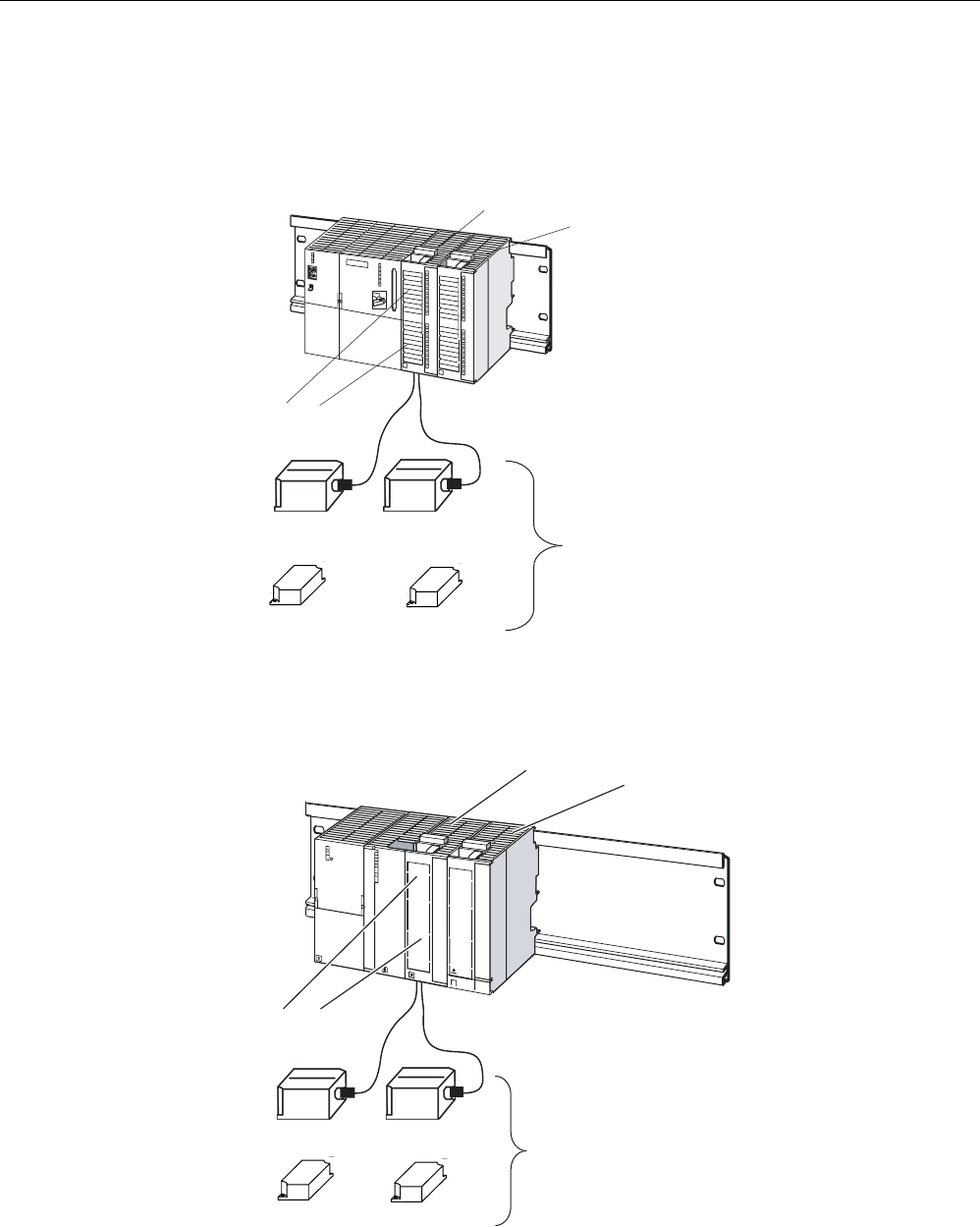
Communication modules
7.1 8xIQ-Sense
RF 300
7-4 System Manual, 05/2005, (4)J31069 D0166-U001-A1-7618, --
7.1.3 Configuration
Centralized S7-300 configuration
6
5HD 5HD
7UDQVSRQGHU 7UDQVSRQGHU
6/*DQGWUDQVSRQGHU
5),46HQVH
)XUWKHUPRGXOHVIURP
WKH6UDQJH
LQFOXGLQJ[,46HQVH
[,46HQVH
$
60FKDQQHO
Figure 7-1 Configurator for 8xIQ-Sense with reader RF 310-R (centralized configuration)
Distributed configuration (ET 200M)
(70
5HD 5HD
7UDQVSRQGHU 7UDQVSRQGHU
6/*DQGWUDQVSRQGHU
5),46HQVH
$
60FKDQQHO
)XUWKHUPRGXOHVIURP
WKH6UDQJH
LQFOXGLQJ[,46HQVH
[,46HQVH
Figure 7-2 Configurator for 8xIQ-Sense with reader RF 310-R (distributed configuration)

Communication modules
7.1 8xIQ-Sense
RF 300
System Manual, 05/2005, (4)J31069 D0166-U001-A1-7618, -- 7-5
7.1.4 Addressing
The address range of the 8xIQ-Sense module is 16 bytes I/O.
This is independent of the choice of channel profiles on the connected device
(i.e. the IQ profile IDs in HW Config).
Access to memory areas
A direct association exists between the number of the channel to which the IQ-Sense device
is connected (terminal) and the input and output data area of the module. Based on the
address range, the following addresses can be used to access the memory areas:
Address = module initial address + (channel no. x 2)
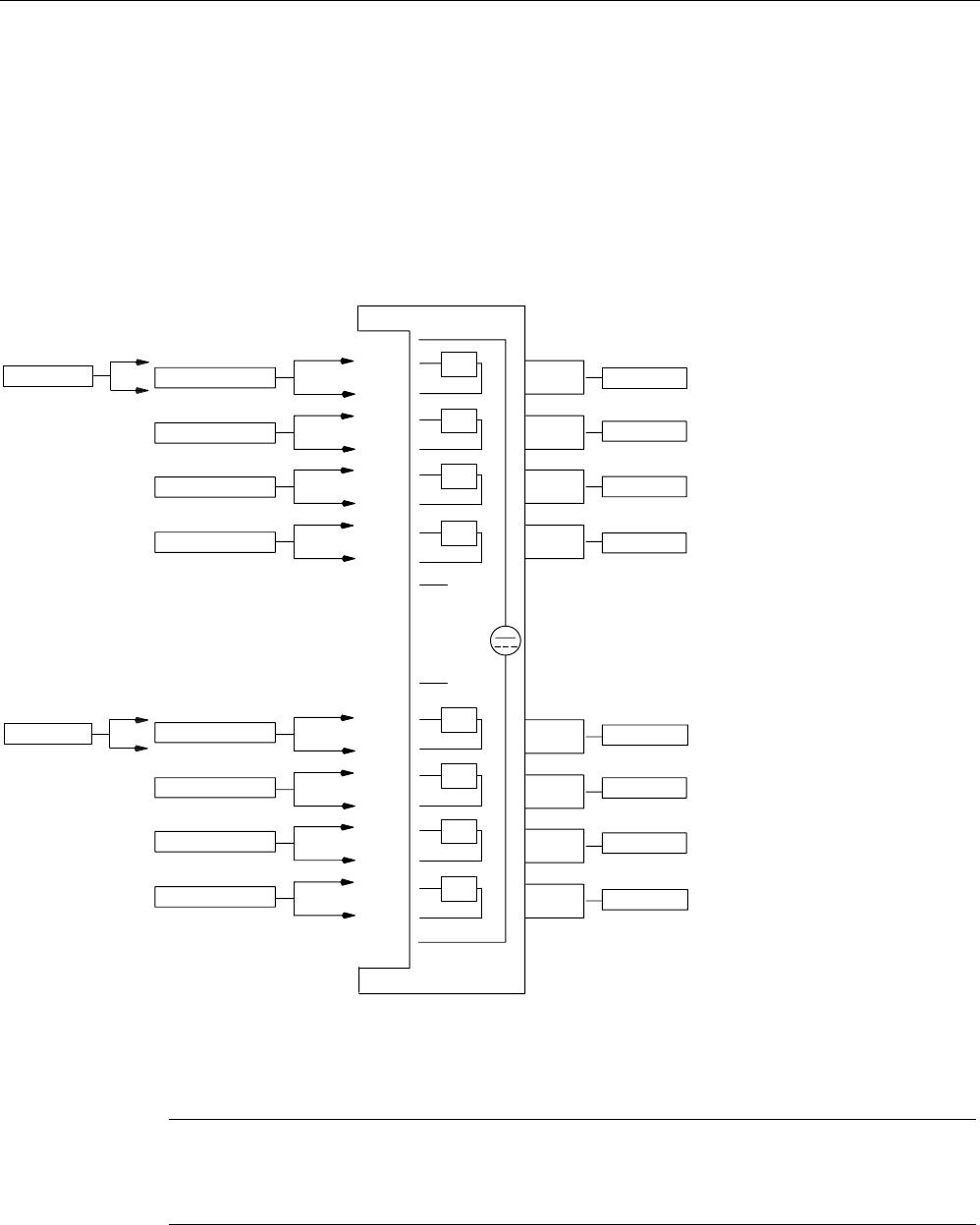
Communication modules
7.1 8xIQ-Sense
RF 300
7-6 System Manual, 05/2005, (4)J31069 D0166-U001-A1-7618, --
Example
Module initial address = 280
I/O address for channel 3: 286
,46HQVHGHYLFH
0
0ದ
0
0ದ
0
0ದ
0
0ದ
0
0ದ
0
0ದ
0
0ದ
0
0ದ
)URQW GRRULQWHULRU
&KDQQHO
7HUPLQDO
&KDQQHODGGUHVVHV
LQH[DPSOH
IRU,46HQVHGHYLFHV
&KDQQHOQR
&KDQQHO
&KDQQHO
&KDQQHO
&KDQQHO
&KDQQHO
&KDQQHO
&KDQQHO
,4
,4
,4
,4
,4
,4
,4
,4
/
0
IRU5)
,46HQVHGHYLFH
,46HQVHGHYLFH
,46HQVHGHYLFH
,46HQVHGHYLFH
,46HQVHGHYLFH
,46HQVHGHYLFH
,46HQVHGHYLFH
5)5
5)5
Figure 7-3 8xIQ-Sense module: Assignment of terminal pair to memory area
Note
A maximum of two read/write devices can be operated!
Each read/write device uses channel numbers 0 to 3 or 4 to 7.
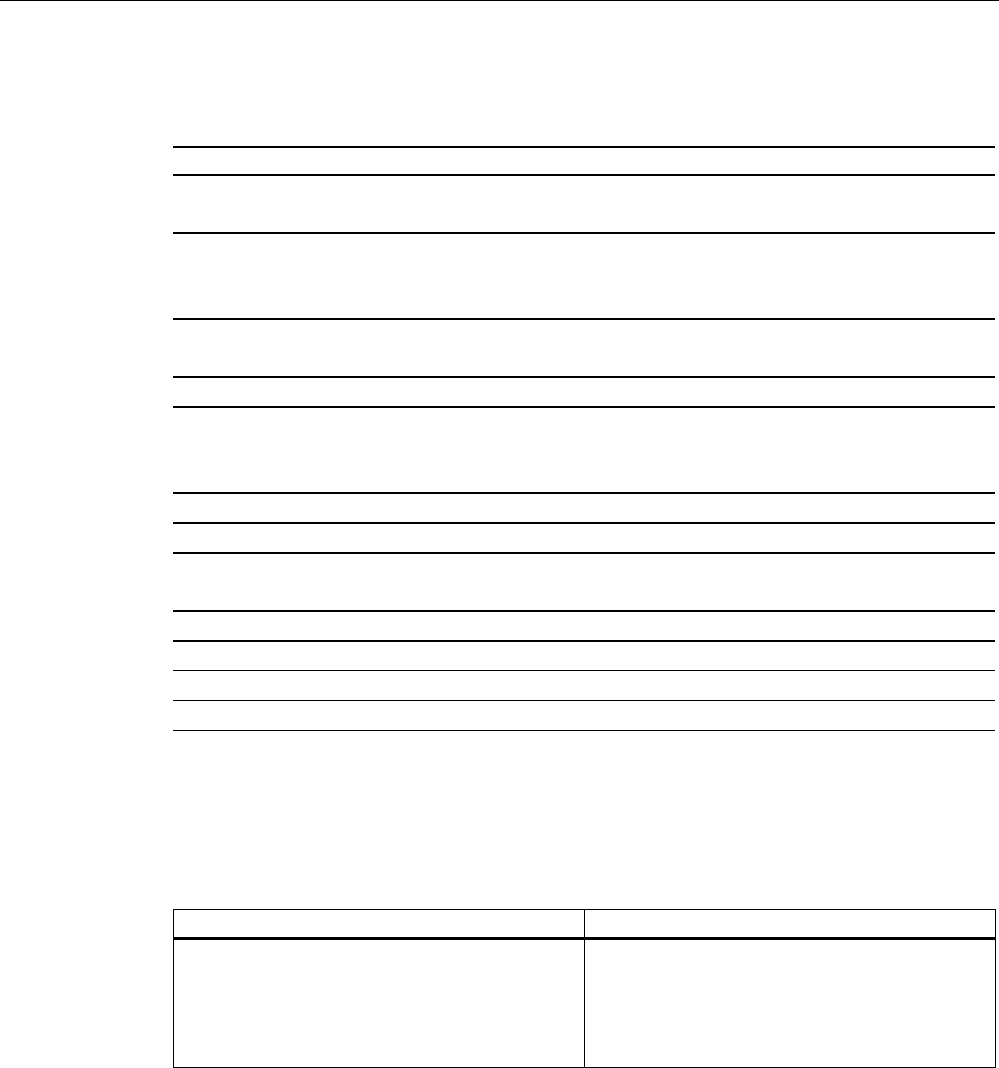
Communication modules
7.1 8xIQ-Sense
RF 300
System Manual, 05/2005, (4)J31069 D0166-U001-A1-7618, -- 7-7
7.1.5 Technical data
Voltages and currents
Rated supply voltage
Reverse polarity protection
24 V DC
yes
Galvanic isolation
• Between the channels
• Between channels and backplane bus
no
yes
Permissible potential difference
Between different circuits
75 V DC / 60 V AC
Insulation tested at 500 V DC
Current input
• from the backplane bus
• from L+ power supply
120 mA typical
500 mA max.
Module power loss 2.5 W typical
Module-specific data
Number of channels
Channels for RFID systems
8
2
Cable length, unshielded 50 m max.
Dimensions and weight
Dimensions w x h x d (mm) 40 x 125 x 120
Weight Approx. 235 g
7.1.6 Ordering data
8xIQ-Sense Order No.
SIMATIC S7-300
IQ-Sense SM338 for S7-300 and ET200M for the
connection of up to 8xIQ-Sense sensors
Optical sensors, ultrasonic sensors and RF
identification systems can be connected.
6ES7 3387XF000AB0

Communication modules
7.1 8xIQ-Sense
RF 300
7-8 System Manual, 05/2005, (4)J31069 D0166-U001-A1-7618, --
RF 300
System Manual, 05/2005, (4)J31069 D0166-U001-A1-7618, -- 8-1
Accessories 8
8.1 8.1 MOBY software
Version 3.0 and higher of the "MOBY Software", product is supplied on CD. The software
includes a complete set of function blocks and drivers for MOBY. The programs are
explained in brief in the "readme" file in the main directory of the CD:
• FC 35: S7 function for the 8xIQ-Sense module
• FB 240: Function block for ASM 450; MOBY on PROFIBUS-DP via SIMATIC S5
(including device data file for PROFIBUS-DP)
• FB 250: Function block for ASM 400
• FB 41 contains a function block for the ASM 410. The call interface of the FB is virtually
identical to FB 250. Please refer to the description of FB 250 for programming
instructions.
• FC 44 can be used to operate the ASM 450 in a SIMATIC S7 environment. It is essential
to read the instructions in the "read_me" file in the FC 44 directory. The "FC 44 for ASM
450" description is available for operation of the ASM 450.
• FC 45: S7 function for the ASM 754
• Function FC 47 for ASM 470
• FB 47 contains a function block for SIMATIC S5 115U - 155U. It can be used to operate
the ASM 470 in a SIMATIC S5 environment via an ET 200M.
• Load program for ES 030 and device data file for connection of the ES 030 to
PROFIBUS-DP
• Test and demo programs for demonstrating the "read from MDS" and "write to MDS"
functions etc. on a PC (Windows). The ASM 424/724 MOBY modules and SIM are
connected to the PC by cable to the serial interface of the PC (COM 1 or COM 2).
• A brief description of the individual directories is provided in English and German
("read_me.txt" and "lies_mich.txt").
• 3964R driver for DOS, Windows 95 and Windows NT
• C library for CCT32 for Windows 95/NT 4.0
• C library for MOBY API for Windows 98/NT 4.0
• Latest edition of MOBY documentation in PDF format
• Tools: you will find utility programs for MOBY configuration here

Accessories
8.1 MOBY software
RF 300
8-2 System Manual, 05/2005, (4)J31069 D0166-U001-A1-7618, --
The "MOBY Software" CD has a user-friendly interface based on HTML. When you run
start.exe, a window appears with the following main menu items:
• FC for S7
• FB for S5
• PC Support
• Doc
• Tools
• Demo
• News
Notes on MOBY software and licensing
When purchasing an interface module or SIM, no software or documentation is supplied. The
"MOBY Software" CD-ROM contains all available FBs/FCs for the SIMATIC, C libraries for
Windows 98/NT, demo programs, etc. and needs to be ordered separately. In addition, the
CD-ROM contains the complete RFID documentation (German, English and French) in PDF
format.
The purchase of an interface module or SIM includes a payment for the use of the software,
including documentation, on the "MOBY Software“ CD-ROM and the purchaser acquires the
right to make copies (copy license) insofar as they are required as part of the customer-
specific application or
development for the plant.
The enclosed contract pertaining to the use of software products against a one-off payment
shall apply in addition.
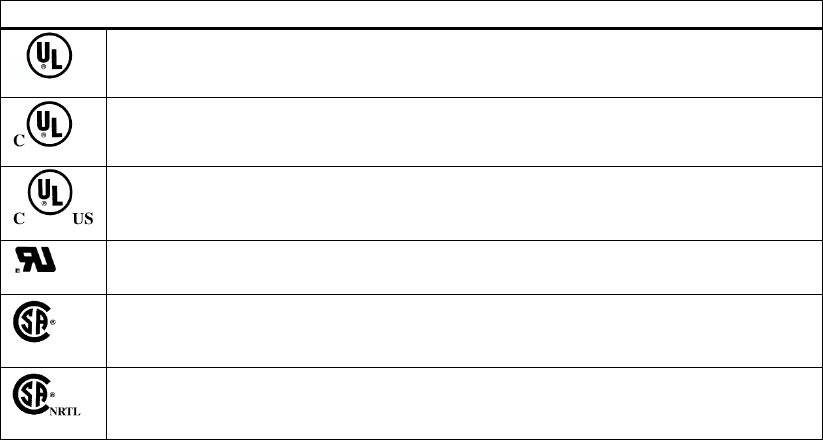
RF 300
System Manual, 05/2005, (4)J31069 D0166-U001-A1-7618, -- A-1
A Appendix A
A.1 A.1 Certificates and approvals
DIN ISO 9001 certificate
The quality assurance system for the entire product process (development, production, and
marketing) at Siemens fulfills the requirements of ISO 9001 (corresponds to EN29001:
1987).
This has been certified by DQS (the German society for the certification of quality
management systems).
EQ-Net certificate no.: 1323-01
Certifications for the United States, Canada, and Australia
Safety
One of the following markings on a device is indicative of the corresponding approval:
Underwriters Laboratories (UL) per UL 60950 (I.T.E) or per UL 508 (IND.CONT.EQ)
Underwriters Laboratories (UL) according to Canadian standard C22.2 No. 60950
(I.T.E) or C22.2 No. 142 (IND.CONT.EQ)
Underwriters Laboratories (UL) according to standard UL 60950, Report E11 5352 and
Canadian standard C22.2 No. 60950 (I.T.E) or UL508 and C22.2 No. 142
(IND.CONT.EQ)
UL recognition mark
Canadian Standard Association (CSA) per Standard C22.2. No. 60950 (LR 81690) or
per C22.2 No. 142 (LR 63533)
Canadian Standard Association (CSA) per American Standard UL 60950 (LR 81690) or
per UL 508 (LR 63533)
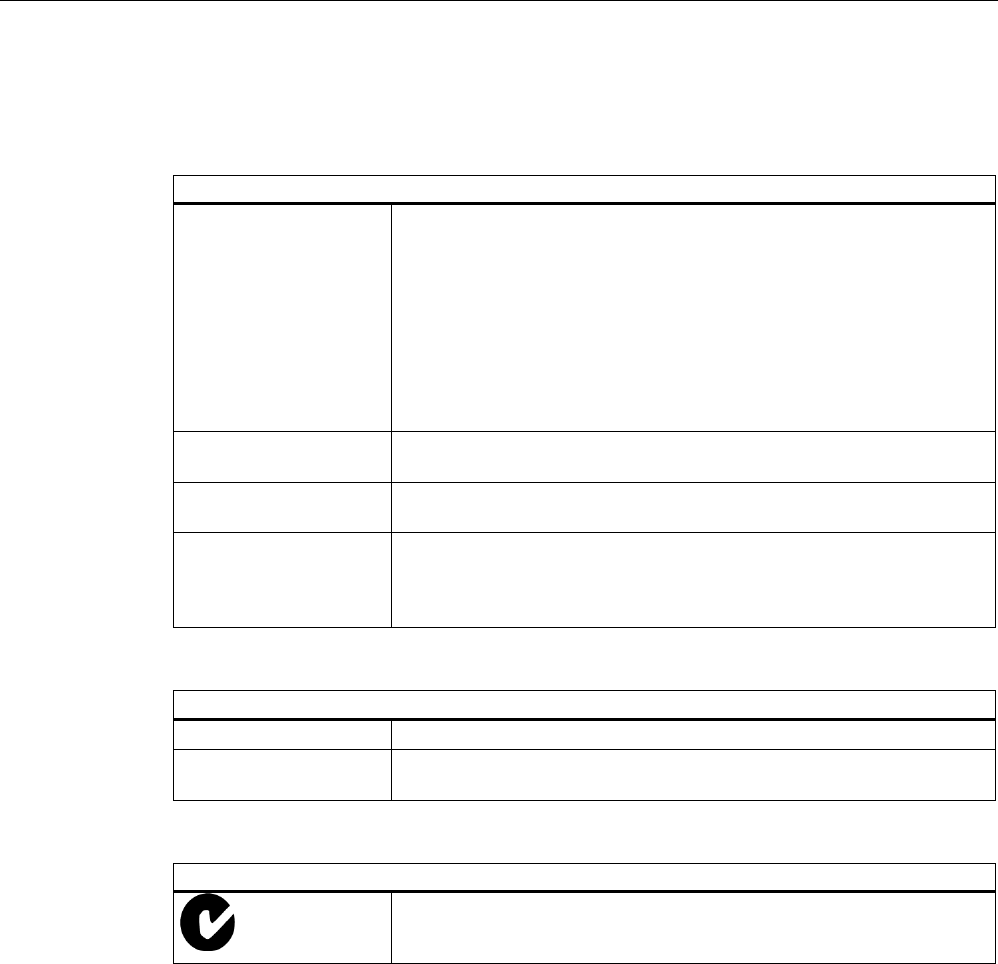
Appendix
A.1 Certificates and approvals
RF 300
A-2 System Manual, 05/2005, (4)J31069 D0166-U001-A1-7618, --
EMC
USA
Federal Communications
Commission
Radio Frequency
Interference Statement
This equipment has been tested and found to comply with the limits for a
Class A digital device, pursuant to Part 15 of the FCC Rules. These limits
are designed to provide reasonable protection against harmful
interference when the equipment is operated in a commercial
environment. This equipment generates, uses, and can radiate radio
frequency energy and, if not installed and used in accordance with the
instruction manual, may cause harmful interference to radio
communications. Operation of this equipment in a residential area is likely
to cause harmful interference in which case the user will be required to
correct the interference at his own expense.
Shielded Cables Shielded cables must be used with this equipment to maintain compliance
with FCC regulations.
Modifications Changes or modifications not expressly approved by the manufacturer
could void the user's authority to operate the equipment.
Conditions of Operations This device complies with Part 15 of the FCC Rules. Operation is subject
to the following two conditions: (1) this device may not cause harmful
interference, and (2) this device must accept any interference received,
including interference that may cause undesired operation.
CANADA
Canadian Notice This Class B digital apparatus complies with Canadian ICES-003.
Avis Canadien Cet appareil numérique de la classe b est conforme à la norme NMB-003
du Canada.
AUSTRALIA
This product meets the requirements of the AS/NZS 3548 Norm.

Appendix
A.2 Service and support
RF 300
System Manual, 05/2005, (4)J31069 D0166-U001-A1-7618, -- A-3
A.2 A.2 Service and support
Technical support
You can reach the technical support team for all A&D projects at
• Telephone: +49 (0) 180 5050 222
• Fax: +49 (0) 180 5050 223
Internet
• Visit our site on the Internet at:
http://www.siemens.com/automation/service&support
• You can send a support query to:
http://www.siemens.de/automation/support-request
• You can find the latest general information about our identification systems on the
Internet at:
http://www.siemens.de/simatic-sensors
• The online catalog and the online ordering system is available at:
http://mall.automation.siemens.com/
A.3 A.3 Contact partners
If you have any further questions on the use of our products, please contact one of our
representatives at your local Siemens office.
The addresses are found on the following pages:
• On the Internet at: http://www.siemens.com/automation/partner
• In catalog CA 01
• In Catalog FS 10 specially for factory automation sensors

Appendix
A.4 Application consulting
RF 300
A-4 System Manual, 05/2005, (4)J31069 D0166-U001-A1-7618, --
A.4 A.4 Application consulting
For questions about special applications, please send an e-mail to the following address:
application-consulting.FAS@siemens.com
or call the following phone number: 0911/895-5775
A.5 A.5 Training
Training center
We offer appropriate courses to get you started. Please contact your regional Training
Center, or the central Training Center in D-90327 Nuremberg.
Telephone: +49 (911) 895-3200
http://www.sitrain.com
RF 300
System Manual, 05/2005, (4)J31069 D0166-U001-A1-7618, -- Glossary-1
List of abbreviations
ASM
Interface module
CSA
Canadian Standard Association
EMC
Electromagnetic compatibility
FB
Function Block
FC
Function
IEC
International Electrotechnical Commission
L
Length of a transmission window
MDS
Mobile data memory
RFID
Radio Frequency Identification Devices
Sa
Operating distance between MDS and SLG

List of abbreviations
RF 300
Glossary-2 System Manual, 05/2005, (4)J31069 D0166-U001-A1-7618, --
Sg
Limit distance
SLG
Write/read device
SP
Intersection of the axes of symmetry of the MDS
Tag
See transponder
TPDR
Transponder
UL
Underwriter Laboratories, USA
VDE
Verband Deutscher Elektrotechniker [Association of German Electrical Engineers]
XPDR
Transponder
RF 300
System Manual, 05/2005, (4)J31069 D0166-U001-A1-7618, -- Glossary-1
Glossary
Active field
Area with minimum field strength containing the transmission window, as well as the areas in
which the field strength is no longer sufficient for data exchange.
Active surface
See active field
Automation system (AS)
A programmable logical controller (PLC) of the SIMATIC S7 system, comprising a central
controller, a CPU and various I/O modules.
Battery-free data memory
Mobile data memories which operate without batteries. Power is supplied to the data
memory across an electromagnetic alternating field.
CE mark
Communauté Européenne (product mark of the European Union)
Data transmission rate
Unit of measurement for the volume of data transmitted within a unit of time, e.g. bytes/s
Dwell time
The dwell time is the time in which the transponder dwells within the transmission window of
a read/write device. The read/write device can exchange data with the transponder during
this time.
Dynamic mode
In dynamic mode, the data carrier moves past the read/write device at a traversing rate
which depends on the configuration. Various checking mechanisms (listen-in check, CRC,
ECC, etc.) ensure error-free data transfer even under extreme environmental conditions. A
serial connection (up to 1000 m) is used to connect the read/write device directly to an
interface module, PC, or any other system.

Glossary
RF 300
Glossary-2 System Manual, 05/2005, (4)J31069 D0166-U001-A1-7618, --
Electromagnetic compatibility
Electromagnetic compatibility is the ability of an electrical or electronic device to operate
satisfactorily in an electromagnetic environment without affecting or interfering with the
environment over and above certain limits.
Equipotential bonding
Potential differences between different parts of a plant can arise due to the different design
of the plant components and different voltage levels. It is necessary to compensate for these
differences by equipotential bonding: this is done by combining the equipotential bonding
conductors of power components and non-power components on a centralized equalizing
conductor.
ESD Directive
Directive for handling ESDs.
Frequency hopping
Automatic search for free channels.
In frequency hopping, data packets are transferred between the communication partners on
constantly changing carrier frequencies. This makes it possible to react to interference from
devices transmitting signals in the same frequency range. If an attempt to send a data
packet is unsuccessful, the packet can be transmitted again on a different carrier frequency.
IQ-Sense interface
Simple interface on the IQ-Sense module, using a standard design for all types of sensors,
enabling integrated data exchange between the sensor and control system.
Limit distance
The limit distance is the maximum clear distance between the upper surface of the read/write
device and the transponder, at which the transmission can still function under normal
conditions.
Metal-free area
Distance/area which must be maintained between the transponder and metal in order to
prevent interference during data transfer between the transponder and read/write device.
Mobile data memory (MDS)
See transponder
Multi-tag capability
Multi-tag capability means the ability to use several read/write devices which communicate
simultaneously with different data carriers.

Glossary
RF 300
System Manual, 05/2005, (4)J31069 D0166-U001-A1-7618, -- Glossary-3
Programmable logic controller (PLC)
The programmable logical controllers (PLCs) of the SIMATIC S5 systems consist of a central
controller, one or more CPUs, and various other modules (e.g. I/O modules).
Read/write devices (SLG)
See readers
Read/write distance
See transmission distance
Reader/writer
See write/read device
RFID systems
SIMATIC RF identification systems control and optimize material flow and production
sequences. They identify reliably, quickly and economically, use non-contact data
communication technology, and store data directly on the product. They are also resistant to
contamination.
Secondary fields
The strength of the secondary fields, which exist in addition to the transmission window, is
usually lower than that of the transmission window and depends on the metallic environment.
Secondary fields should not be used in configuring.
Static mode
In static mode, the transponder is positioned at a fixed distance (maximum: limit distance)
exactly over the read/write device.
Telegram cycles
The transfer of a read or write command takes place in three cycles, known as telegram
cycles. 1 or 2 bytes of user data can be transferred with each command. The
acknowledgement transfer (status or read data) takes place in 3 further cycles.
Transmission distance
Distance between communication module (read/write device) and transponder (mobile data
memory)
Transmission window
Area in which reliable data exchange between transponder and read/write device is possible
due to a particular minimum field strength.

Glossary
RF 300
Glossary-4 System Manual, 05/2005, (4)J31069 D0166-U001-A1-7618, --
RF 300
System Manual, 05/2005, (4)J31069 D0166-U001-A1-7618, -- Index-1
Index
8
8xIQ-Sense module, 7-2
Addressing, 7-5
Configuration, 7-4
Features, 7-2
Indicators, 7-3
A
Active field, 4-2
Active surface, 4-4
Application consulting, A-4
Application Planning
SIMATIC RF 300, 4-1
Approvals, A-1
C
Cabinet configuration, 4-32
Calculation example, 4-9
Certificates, A-1
Communication, 4-7
between RF 300 components, 4-7
Communication modules
8xIQ-Sense module, 7-2
Communication time, 4-7
for fault-free data transfer, 4-7
Configuration, 7-4
Contact partners, A-3
Coupling paths, 4-31
D
Data volume
Relationship between speed and, 4-13
Design
Centralized, 7-4
Distributed, 7-4
Dimension drawing
Reader RF 310-R, 5-8
Direction of motion
Transponder, 4-4
Dwell time
Transponder, 4-6
Dynamic mode, 4-5
Dynamic mode
Dwell time of the transponder, 4-6
E
Electromagnetic compatibility
Coupling paths, 4-31
Electromagnetic interference, 4-29
EMC Directive, A-2
EMC Guidelines
Avoiding interference, 4-35
Basic rules, 4-28
Cabinet configuration, 4-32
Cable shielding, 4-37
Definition, 4-27
Equipotential bonding, 4-36
Overview, 4-26
Propagation of electromagnetic interference, 4-29
Equipotential bonding, 4-36
F
Field data
Readers, 4-12
Reduction due to metal, 4-20
RF 320-T transponder, 6-4
RF 340-T transponder, 6-9
Transponder, 4-12
Flush-mounting
of transponders and readers, 4-16
I
Identification system
Inductive, 3-2
Inductive alternating field, 4-2
Installation
Several readers, 4-17

Index
RF 300
Index-2 System Manual, 05/2005, (4)J31069 D0166-U001-A1-7618, --
Installation guidelines, 4-14
Interference sources
Electromagnetic, 4-30
IQ-Sense interface
Pin assignment, 5-5
M
Main applications
RF 300, 3-2
Metal-free area
Reader RF 310-R, 5-3
RF 320-T transponder, 6-3
RF 340-T transponder, 6-8
Minimum distance
Reader to reader, 4-12
Transponder to transponder, 4-12
MOBY software, 8-1
Mounting options
of transponders and readers, 4-18
O
Ordering data
Reader RF 340-T, 6-11
R
Read/write distance, 4-2
Reader RF 310-R, 5-2
Cable and connector pin assignment, 5-5
Dimension drawing, 5-8
Features, 5-2
Indicators, 5-2
Metal-free area, 5-3
Minimum distance, 5-4
Pin assignment of IQ-Sense interface, 5-5
Reliable data exchange, 5-3
Technical data, 5-6
Readers, 5-1
Mounting, 4-17
Reducing interference due to metal, 4-15
Reduction of field data, 4-20
Resistance to chemicals
Transponder, 4-21
RF 300
Applications, 3-2
Main applications, 3-2
RF 320-T transponder, 6-6
Features, 6-2
Field data, 6-4
Metal-free area, 6-3
Technical data, 6-5
RF 340-T transponder
Features, 6-7
Field data, 6-9
Metal-free area, 6-8
Technical data, 6-10
RFID systems
Overview, 3-1
S
Safety information, 2-1
Secondary fields, 4-3
Service, A-3
Shielding, 4-37
Static mode, 4-5
Static mode
Dwell time of the transponder, 4-6
Support, A-3
System components
Overview, 3-3
System overview
RFID systems, 3-1
Systems
RFID, 3-1
T
Technical data
Reader RF 310-R, 5-6
RF 320-T transponder, 6-5
RF 340-T transponder, 6-10
Time constants, 4-8
Tolerance of pallet side transport, 4-10
Tolerance of pallet transport height, 4-10
Tracking
Tolerance, 4-3
Tracking tolerances, 4-3
Training center, A-4
Transmission window
Impact of metal, 4-19
Width, 4-3
Transponder, 6-1
Active surface, 4-4
Directions of motion, 4-4
Dwell time, 4-6
Mounting on metal, 4-18
Resistance to chemicals, 4-21
RF 340-T, 6-7
Transponder speed, 4-13

Index
RF 300
System Manual, 05/2005, (4)J31069 D0166-U001-A1-7618, -- Index-3
U
User data
Calculation of maximum amount of, 4-7

Index
RF 300
Index-4 System Manual, 05/2005, (4)J31069 D0166-U001-A1-7618, --

Siemens AG
Automation and Drives
Special Products, Projects
Automotive Industry, Training
Postfach 4848
90327 NUERNBERG
Federal Republic of Germany
www.siemens.com/simatic-sensors